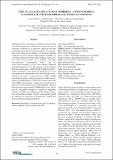Type II collagen-hyaluronan hydrogel - a step towards a scaffold for intervertebral disc tissue engineering

View/
Date
2010-09-06Author
Calderon, Laura
Collin, Estelle
Murphy, Mary
O'Halloran, Damien
Pandit, Abhay
Metadata
Show full item recordUsage
This item's downloads: 2540 (view details)
Recommended Citation
Calderon, L., Collin, E., Velasco-Bayon, D., Murphy, M., O'Halloran, D., & Pandit, A. (2010). Type II collagen-hyaluronan hydrogel ¿ a step towards a scaffold for intervertebral disc tissue engineering. "European Cells & Materials", 20, 134-148
Published Version
Abstract
Intervertebral disc regeneration strategies based on stem cell differentiation in combination with the design of functional scaffolds is an attractive approach towards repairing/regenerating the nucleus pulposus. The specific aim of this study was to optimise a composite hydrogel composed of type II collagen and hyaluronic acid (HA) as a carrier for mesenchymal stem cells. Hydrogel stabilisation was achieved by means of 1-ethyl-3(3-dimethyl aminopropyl) carbodiimide (EDC) and N-hydroxysuccinimide (NHS) cross-linking. Optimal hydrogel properties were determined by investigating different concentrations of EDC (8 mM, 24 mM and 48 mM). Stable hydrogels were obtained independent of the concentration of carbodiimide used. The hydrogels cross-linked by the lowest concentration of EDC (8 mM) demonstrated high swelling properties. Additionally, improved proliferation of seeded rat mesenchymal stem cells (rMSCs) and hydrogel stability levels in culture were observed with this 8 mM cross-linked hydrogel. Results from this study indicate that EDC/NHS (8 mM) cross-linked type II collagen/HA hydrogel was capable of supporting viability of rMSCs, and furthermore their differentiation into a chondrogenic lineage. Further investigations should be conducted to determine its potential as scaffold for nucleus pulposus regeneration/repair.

